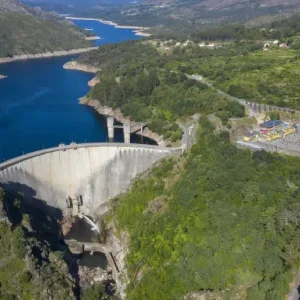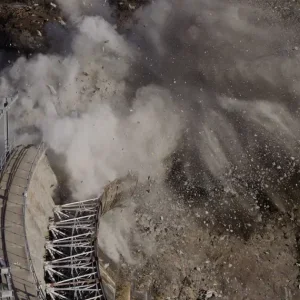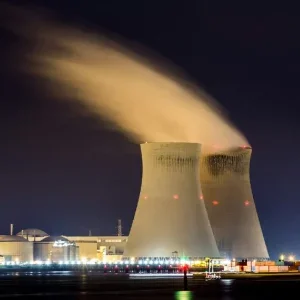
Of all our environmental bogeymen, arguably none are as threatening as coal mines. Filling the atmosphere with CO2 – and blighting landscapes down on earth – much of the developed world has cast them aside. But with proposals for a new coal mine in west Cumbria being considered, could this historic mining region soon witness a heavy industry renaissance?
Andrea Valentino talks to figures on both sides of the debate to explore whether the new Whitehaven facility could offer hope in a benighted corner of England, what it could mean for the environment – and whether it could herald a broader rethink in how mines go about their business.
On 22 September 2021, the famous green tiles to his back, the UK prime minister recently made a typically vivid speech from the dais of the UN General Assembly. His hair ruffled, his white shirt ever so slightly creased, Boris Johnson announced that now was the moment for humanity to “grow up” in its fight against climate change.
“The adolescence of humanity,” he proclaimed, “is coming to an end”. To prove his point, amid the obligatory references to Greek classical mythology, Johnson praised the wind farms now sprouting up in the North Sea – before returning to safer ground with a joke about Kermit the Frog.
Whatever his idiosyncrasies, Johnson is certainly right to praise his country’s environmental revolution. In 2020, renewables provided up to 43% of the UK’s energy needs, while fossil fuels fell to a record low of 37%.
Yet even as Johnson visited New York, exhorting his fellow leaders to put childish environmental fantasies to bed, a far less jovial debate was underway back home. Amid the uplands and rocky coasts of west Cumbria, experts debated a proposed mine near the town of Whitehaven.
Most new schemes raise hackles, of course, but the controversy around the so-called Woodhouse Colliery felt different.
In part, that’s down to history. The September 2021 public inquiry into the mine only happened after the local council approved it three times, the secretary of state intervened, and journalists splattered gallons of ink covering the story. In truth, however, these quarrels can be understood in a single word: coal.
Hoping to revive the region’s tradition of heavy industry, supporters of the project claim the new deep coal mine would offer jobs and support steel manufacturing. For obvious reasons, climate change activists heard ‘coal’ and saw red.
Given the nature of political disputes these days, these questions are unlikely to be resolved soon. What the new mine can perhaps tell us, however, is the way the winds are blowing and how mining operators may eventually be forced to change their operations whether they want to or not.
Coal reception
People have mined in west Cumbria for centuries. The monks at St Bees, just down the coast from Whitehaven, started in the early 14th century, when Edward I was on the throne and the Scots won at Bannockburn. They’ve continued ever since. Even in the 1970s, Whitehaven’s Haig Colliery was extracting around 700,000t of metallurgical coal every year.
Yet since the coming of Thatcher and the closure of the mines, replacement industries have struggled to keep up. The local chemical plant has disappeared, and the nuclear plant at Sellafield is being decommissioned too.
As Mike Starkie explains, that leaves west Cumbria dangerously exposed to the perils of deindustralisation. “There’s been quite a lot of decline in the area,” says Starkie, the Conservative mayor of Copeland, the borough around Whitehaven.
This is certainly supported by the numbers. Though west Cumbria arguably hasn’t suffered quite as much as other parts of England, 14% of households get by on less than £10,000 a year.
In Barrow-in-Furness, an ex-industrial town 40 miles from Whitehaven, around one-third of children live in poverty. These numbers explain the fundamental draw of the Woodhouse Colliery, an underwater facility that could open as early as 2023.
“This new coal mine gives the opportunity for the economy to really diversify,” says Starkie, adding that the new mine could also stimulate local business more broadly.
The harsh reality
According to West Cumbria Mining (WCM), the organisation behind the project, the Woodhouse Colliery would create 500 direct jobs and 1,618 more indirectly, something even the mine’s enemies accept.
“There would obviously be local benefits – from some jobs,” says Maggie Mason, a member of South Lakes Action on Climate Change, a local charity opposed to the project.
Even so, gauging the mine’s economic impact isn’t easy. For one thing, there’s the question of longevity. Initially, WCM had claimed the facility would operate for 50 years. That figure was subsequently cut.
The mine would now close in 2049, something John Ashton, an independent speaker and writer, speculates may have been a concession to try and get the mine past “the obstacle course” of England’s planning system. Mason, for her part, makes a similar point.
Given it’s been decades since miners operated in the area, she worries that any new colliery would need to rely on imported foreign experts. Mason is hardly reassured by the fact that WCM is owned by EMR Capital, an Australian-based company.
And though that quarter-century lifespan isn’t nothing – Starkie notes it represents most of a working life – west Cumbria is arguably better off investing in more enduring industries. One area of interest is wind energy.
“If you look at what’s happened in the North Sea, as offshore wind has taken off in the UK, that should also be happening in the Irish Sea,” says Ashton, who after a career as a diplomat served as the UK foreign secretary’s special representative for climate change for six years until 2012.
“That would create far more jobs than a single coal mine ever could.” Tourism is another alternative. With ruined monasteries tumbling down to pristine pebble coastlines, and literary links with poets like Wordsworth, this remote corner of England could yet become a visitors’ paradise – to 2049 and beyond.
“If you look at what’s happened in the North Sea, as offshore wind has taken off in the UK, that should also be happening in the Irish Sea.” John Ashton, independent speaker and writer
Steel yourself
As the public inquiry into the Whitehaven mine buzzed into life, WCM made a striking assertion. The new facility, the organisation claimed, would emit net-zero carbon.
Beyond technological improvements – methane gas capture, microgrid power generation – it’s an argument that rests on a single central pillar. It goes like this: the coal extracted from the mine would be used in steel production.
At the moment, the UK imports about two million tonnes of coking coal a year from abroad. The Whitehaven mine would fill that need, WCM suggests, in the process cutting the emissions that come with long-distance supply chains. More to the point, says Starkie, there’s vast demand for this type of metallurgical coal.
As ongoing protests around Whitehaven imply, not everyone agrees with this sunny forecast. One of the main objections centres around the quality of the coal itself.
Critics argue – and WCM apparently concedes – that much of the mine’s output couldn’t be used in the UK because its sulphur content is too high.
In practice, says Mason, that would mean most of Whitehaven’s coal would need to be exported to countries like India, where restrictions are more lax.
Naturally, this would damage WCM’s claim of cutting international supply chains from the equation, while British Steel at Scunthorpe has already warned it may be unable to use any Whitehaven coal.
Nerves of steel
Another point of contention is what impact the mine might have on alternative forms of steel production. Though metallurgical coal is currently an essential part of the process – heated into coke, it’s mixed with iron ore before finally being turned into steel – scientists have been busy developing alternatives.
Probably the most encouraging option involves using green hydrogen. But opponents of the Whitehaven project argue that opening a new coal mine could stymie investment in alternatives, while exports to India or China would only fuel unhelpful coal-burning habits.
“There is a real prospect already that hydrogen will become dominant in the industry much sooner” than 2049, Ashton says, emphasising that governments should be pushing hard to end coal-based steel production even more quickly. Nor is this necessarily mere wishful thinking.
In March 2021, for example, the European Steel Association suggested that clean steel technologies could be available by 2035.
Whatever the precise environmental impact of the facility, at any rate, there’s also the question of what it could do to Britain’s green credentials.
Put it like this: might leaders in Delhi or Beijing not laugh at Boris Johnson’s climate activism if his government unveils a new coal mine – something that was pointedly raised to the prime minister by journalists at the recent COP26 climate conference?
“There is a real prospect already that hydrogen will become dominant in the industry much sooner [than 2049].” John Ashton, independent speaker and writer
Mike Starkie, for his part, gives this argument short shrift. Apart from the fact that Britain’s own carbon footprint is comparatively puny, he’s sceptical that giant emitters like China would listen to a middling power like the UK.
As a former diplomat, Ashton disagrees. “It’s nonsense,” he argues, nothing more than a “cheap debating point”. “You know, we don’t live in isolated boxes, one from the other,” he continues.
“Societies influence each other’s choices all the time through diplomacy, including climate diplomacy. The recent announcement by the Chinese government that it will stop financing [overseas] coal-fired power stations – effectively turning off the tap of international public finance for coal power – was a product of diplomacy, including by the UK.”
But as Ashton continues: “Diplomacy only works if you walk your talk. You can’t expect to persuade others to get out of coal while you are giving a green light to new coal mines.”
A shift in the ground
The results of the public inquiry aren’t due out for a while – and even when they are, the final decision will rest with the government in London. But whatever happens with the Woodhouse Colliery, Ashton suggests the controversy is part of a broader shift in global mining.
Whichever way you look at it, mining of any kind has a huge social and economic footprint. At a time of mounting social stresses and ecological emergency, what Ashton calls the “social licence” to mine is likely to become “more demanding” over the coming years.
“If you’re a mining company looking at where to invest next,” he says, ”it’s going to be a good idea to think carefully about how your project will enhance the lives of those who feel its impacts, not only through the livelihoods it can provide but in wider social, cultural and environmental terms.
Otherwise, you risk ending up with a stranded asset, a loss of shareholder value, and massive reputational damage – all of which you would deserve. We need a sustainable mining industry now as much as we ever did.”
That’s doubly true given what mining organisations have done far beyond the rolling hills of Cumbria. To explain what he means, Ashton points to the recent destruction of the Juukan Gorge Caves. Occupied by Aboriginal Australians for 46,000 years, they were smashed by Rio Tinto in 2020.
Ashton, for his part, calls the incident a “morality tale not only for Rio Tinto but for the entire industry”. Fair enough. Yet there are a few signs that operators are gradually changing their ways. Earlier this year, for instance, Anglo-American announced a plan to decarbonise the steelmaking industry.
Rio Tinto, for its part, has developed a blockchain to track the sourcing of sustainable aluminium. These are both good beginnings.
Yet as the Whitehaven project vividly shows, genuine sustainability involves far more than technical innovation, and the gap between theory and practice can sometimes be insurmountably large.
This article originally appeared in World Mining Frontiers winter 2021.






